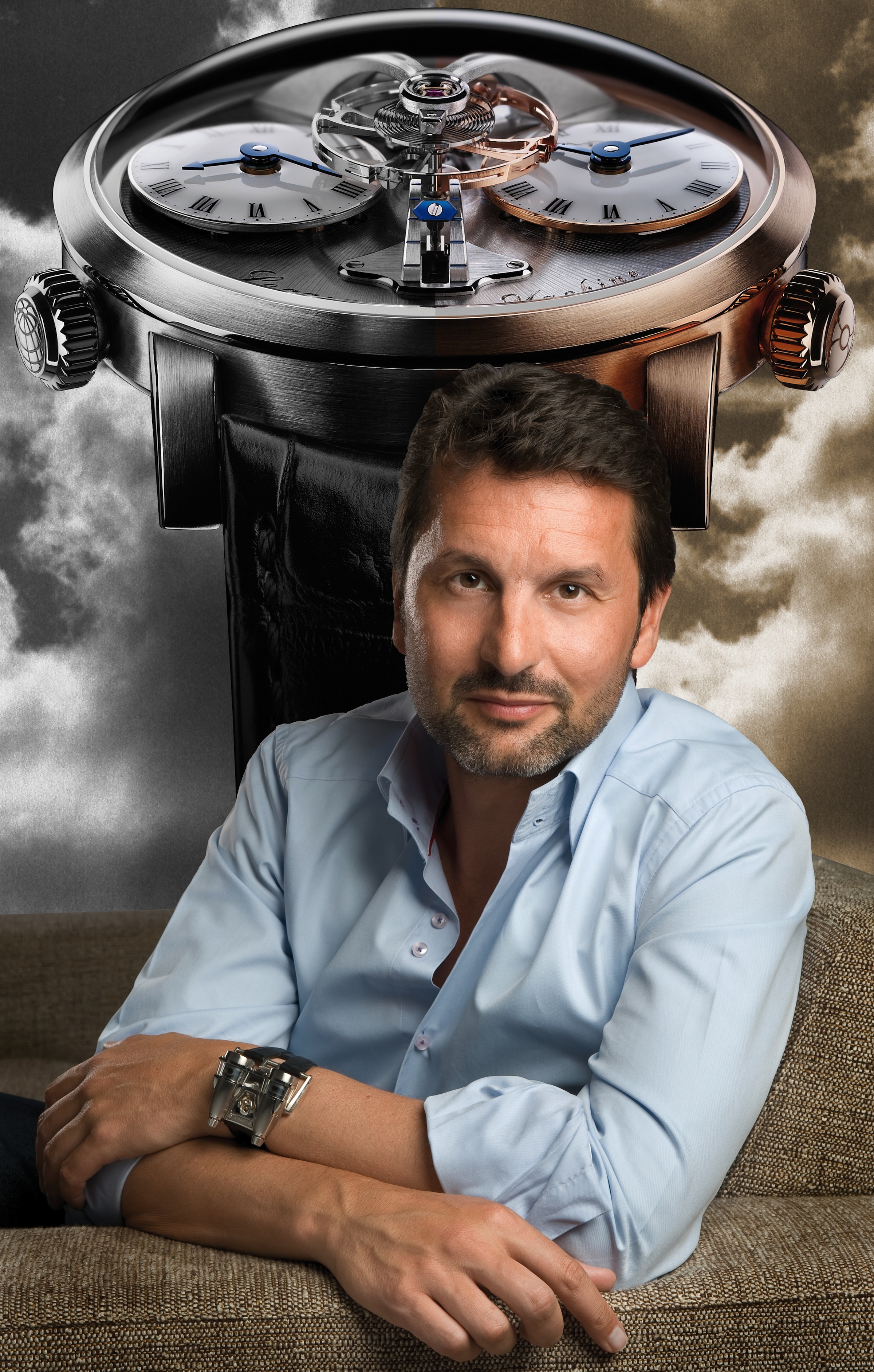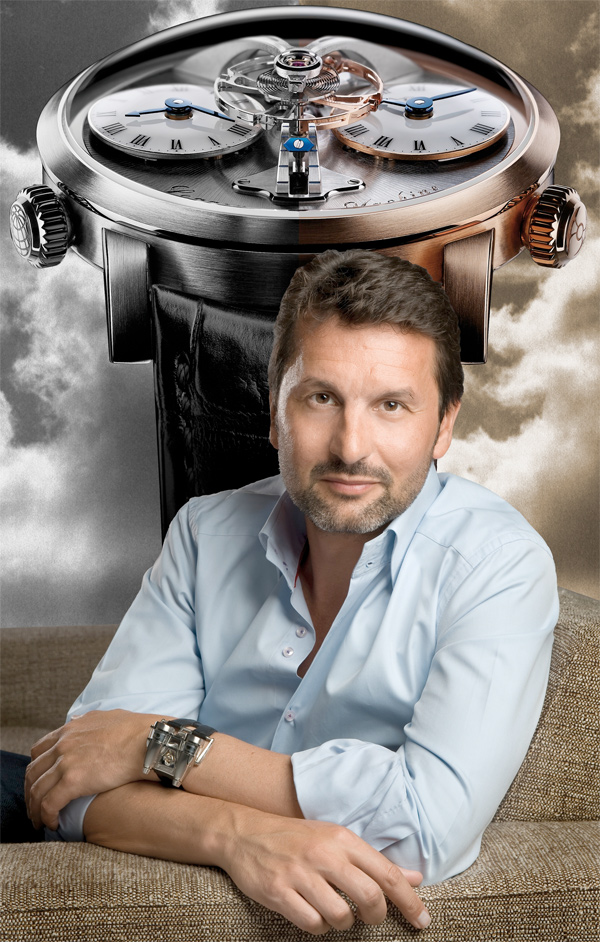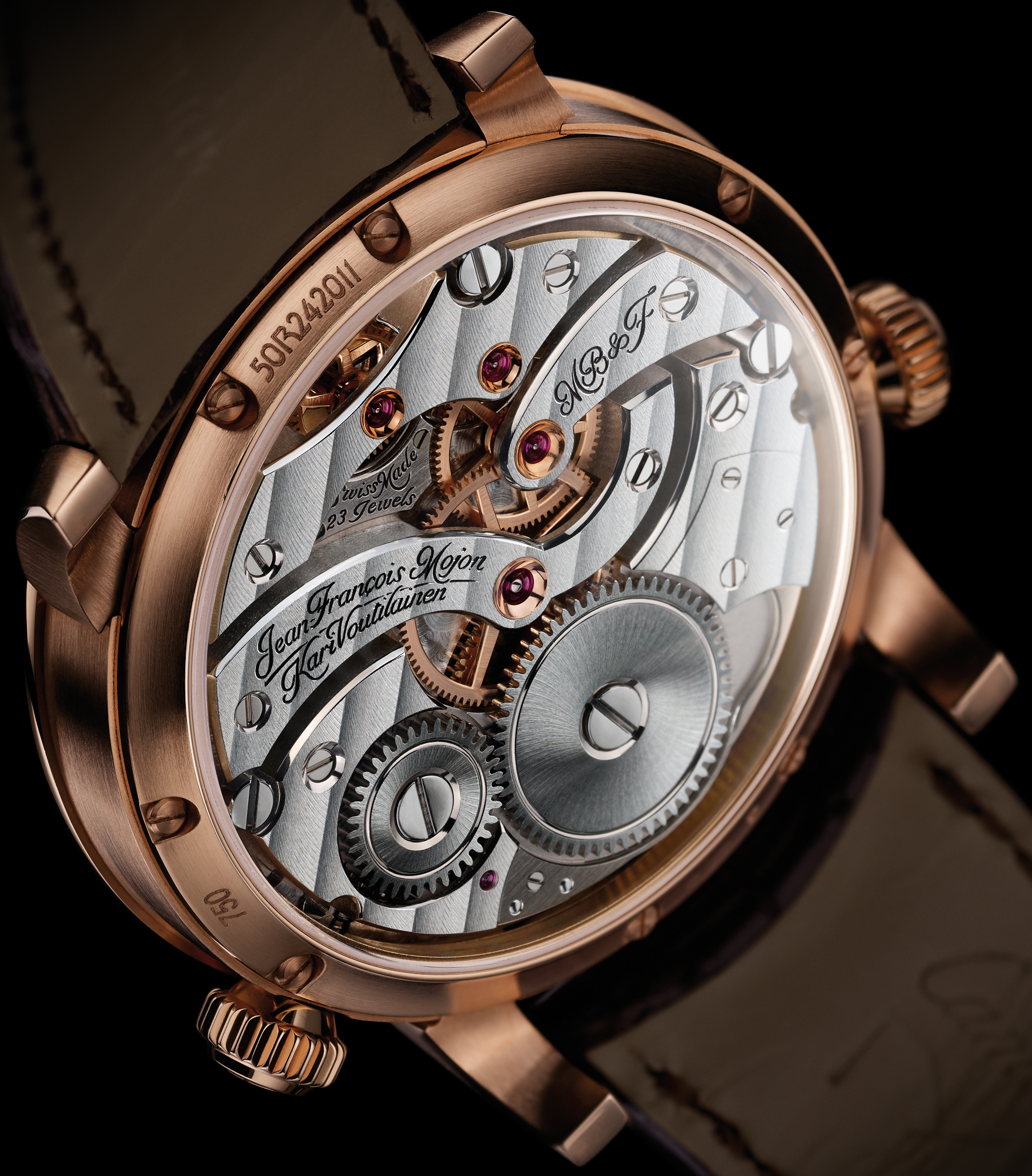 Contributed by David Bredan
Contributed by David Bredan
Read part 1 of the interview here.
MB&F has been playing a major role on the stage of high-end watch making for several years now. However, just like with every blockbuster’s premier, the public’s keen attention is there, but the limelight only shows the final production; and who wouldn’t ever wonder just what’s going on behind the scenes? In the first segment of this three-part interview, Maximilan Büsser told us about exactly that! We found out how he got involved in the seemingly sleepy world of watch making, and we gained a unique insight into just how difficult it is to get a main character’s position.
Now, in Part 2 we get to see how he managed to continue after all the massive early challenges, what are his fundamental (and as we will see, very unique to the watch making world) values and motives behind every new act of MB&F, the obstacles these create, how and why in his opinion the public’s perception has changed about their work, and we receive a privileged hint about what MB&F is to premier in Baselworld in just a few weeks!
aBlogtoWatch (ABTW): Now, being familiar with all the major ups and downs of the beginning I wonder how did you figure out: ‘what’s next’?
Maximilian Büsser (MB): Our timeframes are so long in research and development, engineering, creating prototypes and pre-series runs that there is no way I could only have had HM1 when I created MB&F. HM2 had already been designed, as were the sketches of HM3. Actually, when I went to see the retailers for the first time in November 2005, they already saw the designs of HM2 albeit not in the final form of the product.
We develop continuously and in parallel. What is interesting in this process – and what is pretty frustrating for me – is that for example in December last year I unveiled HM5 which was at the time, a world premiere. For me it is a four and a half years old project! [laughs] Virtually old stuff! So when it is presented, I am of course enthusiastic and tell people how proud I am of it. And I am proud. But I’m working on HM8 – as HM6 and 7 are virtually finished – and on LM5 and LM6 as LM2, LM3 and LM4 are virtually finalized also. Products which you are going to see in 6-7 years. That is what gets my adrenaline pumping.
And indeed, our creative process has not much to do with other brands because we don’t analyze the market. We really don’t care what the trends are; if watches are getting slimmer or bigger, if they are all black or red gold, if they’re 10 days power reserve or 20 Hertz… We create what we believe in! I am what I am creating today: a piece that you will probably be seeing in 4-6 years. The MB&F products you are seeing today were created by the man I was 3-6 years ago. And that is a very amazing creative process!
I designed HM1 in 2003 – and remember when Peter Speake-Marin presented me with the first finished prototype, I thought ‘Oh damn! Nobody is ever going to buy this, it’s never gonna sell!’. I loved it, I had longed for this piece, I created the piece I believed in… but I didn’t think that anybody would have the courage to wear it. And I nevertheless still went along. Now, eight years down the road when I look at HM1, it seems quite a conservative piece of watch making…, because what we are working on is even much wilder than HM4!
Most brands, when launching a product, show it in Geneva or Basel, see if it is a success, and then if there are many orders think ‘Oh, it’s a sellable product, we have to expand on it!’. We never reason that way, We need to sell a minimum amount, so it finances the next creation but that is where the sales process stops. Because if we don’t sell the pieces now, there are no next HMs, no next LMs. It’s a flow process. That’s why I work and travel so much – it’s not for the money, it’s to collect amongst others, enough sales so that I can create the next piece. All I do to market my products is to fuel the next idea !

‘HMs are incredibly complex movements which are truly beautifully finished;
something most people don’t realize because they are only focused on the shape.’
ABTW: I wish that was more common, but it isn’t, as most creative people have an owner or an investor looking over their shoulders and often forcing more conservative ways. It’s easy to see that this is not the case here and that clearly shows in all of your Machines in my opinion.
MB: Exactly. You have to realize one thing: shareholder value can be the biggest enemy of innovation. That is pretty apparent in most industries. The bigger your company is, the more revenue it generates, the more growth it needs to give to the shareholders – and the less risk you can take. If not, first of all the CEO will probably get fired; secondly the shear amount of overhead can tame even the hardiest creator. Could I take the risk of creating an HM4? No! I’ll need to create a trendy piece which will sell quickly in thousands of pieces. I really cannot create a piece while thinking ‘Oh damn, no one is ever going to buy this!’. And that’s why most creativity I see today in the watch industry comes from the smallest entities. It’s not that the big ones don’t have ideas or that they are smarter or not as smart as others – it’s just that the risk they are allowed to take is not the same as we can.
ABTW: I see all this creativity and enthusiasm going into the Machines and it definitely makes me curious about something: if you could do something else – I know you wanted to be a car designer –, what would it be? In other words do you plan on extending your and hence MB&F’s operation to beyond watch making?
MB: Two to three years ago when journalists would ask me I would answer ‘No, there are so many more ideas I want to explore in watch making that I have no intention to create something else.’ And they were all pretty disappointed. Well, in Basel, in a few weeks, we will unveil the first MB&F Machine which doesn’t give the time. The first piece of MB&F kinetic art which is not a watch. I designed it with Xin Wang, a young design graduate from ECAL. It was an idea which had been niggling in my mind for some time. Once the design was finished, we visited the only manufacturer who could craft it, and now the first MB&F Machine which doesn’t give time will soon be unveiled ! That creative adventure really whet my appetite, so am now working on different other projects which relate to kinetic art. Even though it was I dream in my youth, I am no longer interested in designing a car because it would boil down to designing a bodywork. It would just be a design.
What I regret most in many new products is that designers come up with new shapes. No one needs a new shape, we need instead a real story! A product needs a real soul, something tangible behind it.
ABTW: I know you and some of your Friends travel a lot, meeting the public and the press, introducing your latest pieces. That means you get their feedback directly. I would like to find out whether you have experienced a change in the public’s perception of your work. You said that the HM1 now appears to be extremely conservative, while when you created it it was out of this world. Seeing how your opinion about it has changed I would like to hear what you feel about the public: how did they react then and how do they react now to your work?
MB: It’s clear that there has been change. The brand has amazed and is now generating expectations. At the beginning of this adventure, there were no expectations, nobody paid much attention to us! Now, after six Machines, the public demands to be amazed. I cannot be unsettled by that! I just want to enjoy myself and create what I believe in.
It is interesting that for example if you analyze the public forums when HM5 was launched it got a lot of negative feedback. Two things happened: A) we never had such a fast sell-out, the 66 pieces are all sold, the retailers all told us they have deposits and need the pieces as soon as possible. B) It disheartened part of my team: ‘We’re getting killed on the forums, people are saying they are disappointed’, and I had to remind them: ‘you forget that when we came out with the HM4 most said ›this is crazy; this is a toy; this isn’t watch making; who the hell do they think they are‹?’ – we got hammered! When we came out with Legacy Machine it was worse! People said ‘ahh, now they’ve gone commercial!; now they’ve sold their soul!’, etc. There will probably be more and more criticism as the expectations are growing higher and higher, but I will need to NOT pay attention to this. You need to take creative risks in life and not be unsettled by criticism. What really matters is that everything we craft is on the wrist of someone who understands us. As I told my team: ‘remember one thing, if everybody likes what we do, we are doing something very wrong.’
ABTW: That would be the moment when you would have gone commercial. On a personal note, I exactly remember the occasion when I first saw LM1 and while it is a major leap from the Horological Machines it definitely wasn’t a commercial feeling, I can tell you that.
MB: Well, I have to say that LM1 was probably our biggest risk to-date. When people think it was a safe bet, it was actually the contrary – and luckily I didn’t realize what I was doing. Indeed up until HM4 virtually no one would compare MB&F watch making to any other watch making. You would not hear ‘Oh, the Thunderbolt is better, or worse than a Patek or a Lange?’. But as soon as we created a round watch we opened the door to ‘Hey, look at the finish here or the construction there!’ people could finally compare and in this case the comparison spoke for itself. Kari Voutilainen was absolutely incredible in this adventure. When we began the project I told him he had complete free range in defining the design and the finishing of the movement. It was after all, the first time he was going to put his name on a creation which was not his.
The Legacy Machine is our decoding machine, it says: HMs are incredibly complex movements which are truly beautifully finished; something most people don’t realize because they are only focused on the shape. Now for example, when we show an LM most cognoscenti will have to admit that the finish on the movement is of the absolute highest standards. Well, the hand finish on our HM4, 3, 2 and 1 is done by the same workshop in the Vallée de Joux as our LM1. I rest my case.
ABTW: The last thing that I would like to ask you is about the distant future: the majority of high-end watch making manufacturers are several decades, or even centuries old: I wonder, can you imagine MB&F or something that says MB&F on it 150 or 200 years from now?
MB: I don’t know. I live the present, I am writing my story. This is my autobiography, not a science-fiction novel. What I mean by that is I’m not trying to imagine what watch making will be in 10-50-100 years; I’m just enjoying myself expressing myself. It’s interesting to consider that in a Christie’s sale when an HM4 Thunderbolt will come up for sale will people say: ‘Crazy design from a crazy guy who lived 100 years ago’; ‘the beginning of a new era of watch making which then became something signifcant; or else ‘the beginning of a trend which died later on’. There is no way I will know and, honestly, I can’t start wondering what people are going to say about my brand in a hundred years because that is not what I set out to do.
I of course want it to continue – I want it to continue as a pure creative process, as a base to engage people to think differently. To create something which is powerfully personal. The reason why brands where the creator was some sort of an innovator and then passed away still exist today with a very strong identity is because there were great art directors to call for. And what I would like for MB&F to continue is that the day I stepped down to have a really powerful art director who continues in such powerful ways. It does not have to by my way, but it has to be something which engages.
This has been the second segment of a 2 parts interview with Maximilian Büsser of MB&F. I hope that this has provided a unique insight into the past, present, and future of one of modern watch making’s most influential men, and most innovative, most creative brands. I am confident that modern horology would not be the same without his and his Friends’ work and wish that we can keep on bringing you their latest and craziest creations for a long time!
This is part 2 of a 2 part interview.


